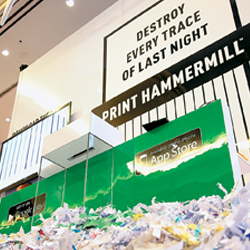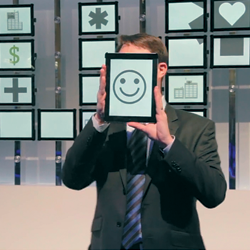|
case study
 Lightbulb Moment:
How Cree Lighting Reset its Strategy to Meet Attendees' Needs To regain the spotlight in a crowded market, Cree Lighting reinvents its booth strategy, trading a company-focused approach for an attendee-centric design. Using direct applications and real customer stories, the firm increases A- and B-quality leads by 133 percent. By Linda Armstrong
exhibit design
Exhibitor: Cree Lighting, a company of Ideal Industries Inc.
Show: Lightfair International Design/Fabrication: Impact XM, Dayton, NJ, www.impact-xm.com Size: 50-by-80 feet Challenge: Hoping to stand out in a now-crowded marketplace (while increasing qualified leads, press mentions, and social-media impressions), Cree Lighting needed to flip the switch on its company- and product-focused strategy. Solution: To create an attendee-centric exhibit, Cree Lighting polled its customers, identified their needs, and reinvented its approach, focusing on application-based vignettes, sessions, and demos that highlighted real-world integrations and customer stories. Along these same lines, its trade show exhibit hasn't merely kept pace; it has often set the standard. At shows such as Lightfair International, the company's booth went high beam to high beam with some of the lighting industry's colossal brands. But all Cree Lighting needed to stay ahead of the pack was its depth and breadth of products – a differentiator competitors simply didn't have. "Initially, traditional brands weren't excited about switching to LED lighting," says Carrie Martinelli, director of marketing communications and events at Cree Lighting. "Since our sole trade show focus was LED from the beginning, attendees immediately saw us as different and innovative." While other exhibitors were still hawking incandescents and fluorescents, Cree Lighting's exhibit highlighted its wide array of LED products. Featuring a central presentation theater, which hosted an intelligent-lighting session every 30 minutes, the 50-by-70-foot booth was what Martinelli called a "yard sale in the ceiling." Overhead lighting was everywhere, organized by product groupings. For example, there was one area for troffer lights, another for high-bay fixtures, and additional areas for track lighting, wall mounts, floods, and more. For the most part, Cree Lighting only needed to display its wares, and attendees came running. But starting around 2015, the lighting industry underwent a shift. Brands that had been dragging their feet with regard to LEDs finally abandoned their old-school technology and began sprinting toward LED land. Plus, newcomers abruptly appeared on the scene. "Three or four years ago, the competition rapidly made the switch to LED en masse, and LED lighting was everywhere at Lightfair," Martinelli says. Seemingly overnight, Cree Lighting's once cutting-edge yard sale was old news. In fact everybody had their own yard sales, which meant Cree Lighting needed a way to stand out at trade shows. Illuminating the Issues To help her firm regain its pioneering status, Martinelli knew she'd need a total program overhaul. But she also understood that putting attendees' needs and preferences center stage was paramount. To that end, she set out to determine exactly what customers and prospects wanted in the way of a booth design. Luckily for her, Cree Lighting already had a customer council of roughly 10 of the industry's top architectural and lighting designers representing the company's main target markets, which range from education and transportation to health care and industrial. So in late 2017, Martinelli peppered the council with queries to help her reinvent Cree Lighting's exhibit. "We asked them what they wanted to see at the show, how they wanted to engage with products and staff, what information they needed and didn't need, and what we should avoid," she says. The council's answers boiled down to one main directive. "Overwhelmingly, the message was that we needed to move beyond providing a plethora of product data, as attendees were getting lost in a sea of product specs," Martinelli says. "They felt our previous booth was focused more on us than them. Rather, we needed to tell real stories of customers using the products and offer case studies illustrating how our technologies and solutions impact our clients." Along with the council's clear directive, Martinelli had several marketing goals of her own on her design wish list. While the existing stand always seemed to draw a crowd, lead quality was lacking. Martinelli believed the product overload was preventing buyers from fully understanding how the fixtures could be applied to their specific environments. Without this knowledge, she surmised, high-quality leads didn't request post-show follow-up. As such, some of what might have been A-level leads weren't collected. Going into 2018, she hoped the new approach would address this problem and improve lead quality. 
In addition, while she wanted to retain the theater presentation that had drawn relatively steady crowds in the past, she aimed to improve its content and scheduling. "In 2017, we had an expert talking about the features and benefits of our technology, how it was invented, and how Cree Lighting is different," Martinelli says. Given the council's mandate, she knew the content should be more focused on actual customer stories, but she also wanted to modify the manner in which the content was offered and create scheduling that would prompt repeat visits.
"Previously, you had to show up at just the right time to see the full presentation," she says. For 2018, she wanted to break down that somewhat lengthy live presentation into bite-size chunks organized by how customers use the fixtures and offer varied topics to meet the multiple needs of a wider audience of buyers. She also hoped to integrate partners and customers to help tell the stories the council craved. What's more, Martinelli planned to elevate the effectiveness of the company's social-media and press efforts. To do this, she'd need compelling demonstrations – preferably those that were highly visible and easily shared on social media – along with an attraction that would generate show-wide buzz. Arcs de Triomphe Going into Lightfair 2018, Martinelli employed many of the same promotional tactics she'd used in years past, such as a show-specific landing page highlighting various booth offerings, corresponding promotional emails directing people to the page, and social-media posts on Facebook, LinkedIn, and Twitter. However, the crux of her new strategy was a fresh booth design by Impact XM. While the 50-by-80-foot exhibit was certainly a stellar structure boasting angular lines, bold blue-and-white Cree Lighting branding, and repeated diamond-shaped patterns referencing the firm's logo, its true triumph was the application- and customer-centric approach inherent in its four dramatic arches, each one of which represented a different application, namely industrial and office, education, health care, and roadways. Each 12- to 16-foot-tall arch featured corporate-blue laminate on the exterior surfaces while the interior walls and "ceiling" offered product displays, videos, graphics, and hands-on demonstrations specific to its application. While each arch presented different products, the four structures maintained a similar organization. And once attendees understood the pattern, they could easily navigate the entire exhibit.
"The message was that we needed to move beyond providing a plethora of product data, as attendees were getting lost."
For example, the industrial and office arch on the front left corner of the space presented images of two related locales that incorporate Cree Lighting's
products. Designers covered the interior of one side of the arch with realistic office imagery and then embedded light fixtures typically used in this setting into the structure's ceiling. On the opposite wall designers used an image of a massive warehouse, and the ceiling housed industrial fixtures.As visitors approached this space, staffers spoke with them about their needs, offered general product and application information, and then introduced them to a table-based touchscreen monitor positioned under the center of the arch. Here, attendees could employ smart technology from Cree Lighting and its partners to alter the intensity and quality of the overhead warehouse fixtures. Visitors could also access a wall-attached touchscreen in the center of the office image that offered a choice of videos ranging from general product info to customer case studies showing the various office and industrial products in use. Similarly, the education arch displayed two different scenes on its walls: a library interior and the exterior of a school. Near the outside imagery, designers mounted fixtures often used in this environment. However, for the interior applications, a more intricate display illustrated how Cree Lighting's SmartCast system integrates with the BACnet system from Johnson Controls Inc. 
Each of the other two arches – for roadway and health-care uses – offered similar application-based information, displays, first-person customer videos, and live demos, the latter of which Martinelli filmed and posted online and via social media to generate further attention and impressions. And given the continuity between the four arches, visitors quickly grasped the organizational methodology and tended to linger longer than in years past. "By doing away with the product-type grouping and using arches specific to various real-life applications, we developed a whole new level of storytelling," says Paul Struncius, senior account director with Impact XM. "The four arches allowed attendees to interact with staff and the products in a far more effective and authentic manner." Cree Lighting's customer-centric approach carried over to its in-booth presentations as well. Positioned on the right side of the booth, an open-air theater offered five bench seats to accommodate 10 to 15 attendees per session. Meanwhile, a front-and-center wall comprising the company's LED products displayed video and still images during live presentations. Martinelli replaced the previous year's lengthy company- and product-focused sessions, which were repeated every half hour during the show, with nine different 10- to 15-minute presentations each day. Scheduled to start every 45 minutes, the sessions ranged from actual client case studies (sometimes with the customers or partners co-presenting) to industry outlooks and live product demos. Over-the-Top Attraction While the theater and arches certainly drew attendees to the space, it was the booth's Arcadia Experience that had hordes of people cued up, velvet ropes and all, for a mere two-minute encounter. The ceiling-mounted Cree Lighting Arcadia System (which has recently been rebranded as Cadiant) pairs Cree Lighting's intelligent lighting controls and color-changing capabilities with advanced 3-D forms and driver technology to deliver ambient light that mimics the progression of the sky throughout the day. In effect, the fixture brings the outdoors into any room. To promote and demo this technology, Impact XM created a 16-by-16-foot space near the center of the exhibit. Directly above this fully enclosed room, which included a ceiling, designers installed a 16-by-16-foot horizontal LED display that showcased brilliant moving images of a gorgeous blue sky and puffy white clouds. Acting like a massive skylight mounted over the stand, the LED screen attracted scores of curious visitors. 
As she spoke, the ceiling fixtures cycled through a normal 24-hour sequence in two minutes. Light started with a bright morning sun and then morphed into midday heat, complete with simulated passing clouds. Then the light dimmed to a mild afternoon thunderstorm, and ultimately the environment mimicked a soothing sunset. A sound- track of various background noises corresponded to the lighting changes. For example, the early morning chirping of birds eased into sounds of a gentle rain, then low thunder, and eventually evening crickets. "Many people were so intrigued by the presentation that they got right back in line to wait their turn to experience it once again," Martinelli says. But for those that wanted more technical specs, a monitor attached to the room's exterior wall offered charts and graphs showing the characteristics of the experience's light output. Lighting designers could see in graphical and technical terms what they'd just witnessed during the immersive encounter.
175%
The Sky's the LimitBy focusing on user applications, Cree Lighting increased its media mentions by 175 percent. Going into the show, Martinelli suspected the Arcadia Experience would be an effective traffic builder – and with 2,396 attendees (almost 10 percent of the show's total attendance) taking part, it certainly was. However, impressions from at-show social-media posts and promotions – along with press interviews and overall media stats – also soared sky high. By the time the luminaires went out at Lightfair, views of Cree Lighting's online videos (which featured in-booth demos and presentations) had increased by 447 percent compared to the 2017 show. In addition, social-media impressions grew by 20 percent, as did overall lead scans. And as Martinelli had predicted, since the booth was reorganized into applications that allowed visitors to better understand and digest how Cree Lighting's offerings directly applied to them, lead quality shot up as well. Compared to 2017 stats, the number of A and B leads collected increased by a whopping 133 percent. Martinelli and internal Cree Lighting stakeholders were obviously pleased with the stellar results. And members of the press also took notice, as post-show media placements increased by 175 percent over the previous year. So by using the advice and insight of its customers, Cree Lighting traded its yard sale in the ceiling for highly organized, logical product presentations. Using real-life applications and customer stories to tell its tale, the company regained its position as a leader of the pack – and kept complacency and the status quo safely in its rear-view mirror. E
Seven-Step Evolution
Hoping to reinvent its exhibiting strategy and regain its status as an industry leader, Cree Lighting implemented the following tactics. 1. Probed the company's existing customer council to ascertain their booth-related needs and preferences 2. Adjusted the booth strategy to meet customers' needs, switching from a product- to an application-based design 3. Employed traditional pre-show promotions, e.g., a show-specific landing page, emails, and social-media posts, but added videos of in-booth demonstrations and presentations to drive booth and online traffic 4. Designed a new 50-by-80-foot exhibit comprising four dramatic arches that each corresponded with a customer application: industrial and office, education, health care, and roadways 5. Devised interactive demos within each arch to allow attendees to interface with the lighting products in settings specific to their needs 6. Provided nine different 10- to 15-minute presentations within an in-booth theater and enlisted customers and partners as co-presenters whenever possible 7. Offered the Arcadia Experience to demo an upcoming product and draw passersby to the space
|
|
|
||||||||||||||||||||||||||||
|
|
||||||||||||||||||||||||||||
|
TOPICS Measurement & Budgeting Planning & Execution Marketing & Promotion Events & Venues Personal & Career Exhibits & Experiences International Exhibiting Resources for Rookies Research & Resources |
MAGAZINE Subscribe Today! Renew Subscription Update Address Digital Downloads Newsletters Advertise |
FIND-IT Exhibit & Display Producers Products & Services Supplier to Supplier All Companies Compare Get Listed |
EXHIBITORLIVE Sessions Certification Exhibit Hall Exhibit at the Show Registration |
ETRAK Sessions Certification F.A.Q. Registration |
EDUCATION WEEK Overview Sessions Hotel Registration |
CERTIFICATION The Program Steps to Certification Faculty and Staff Enroll in CTSM Submit Quiz Answers My CTSM |
AWARDS Sizzle Awards Exhibit Design Awards Portable/Modular Awards Corporate Event Awards Centers of Excellence |
NEWS Associations/Press Awards Company News International New Products People Shows & Events Venues & Destinations EXHIBITOR News |
||||||||||||||||||||
|
||||||||||||||||||||||||||||






